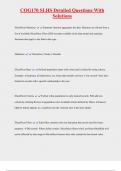Exam (elaborations)
COG170 SLHS Detailed Questions With Solutions
- Course
- Institution
COG170 SLHS Detailed Questions With Solutions SlicerDicer Measures Summary function aggregates the data. Measures are chosen from a list of available SlicerDicer Filers (FDS records) available in the data model and summary functions that apply to the filter's data type. Databases Chronicles...
[Show more]



